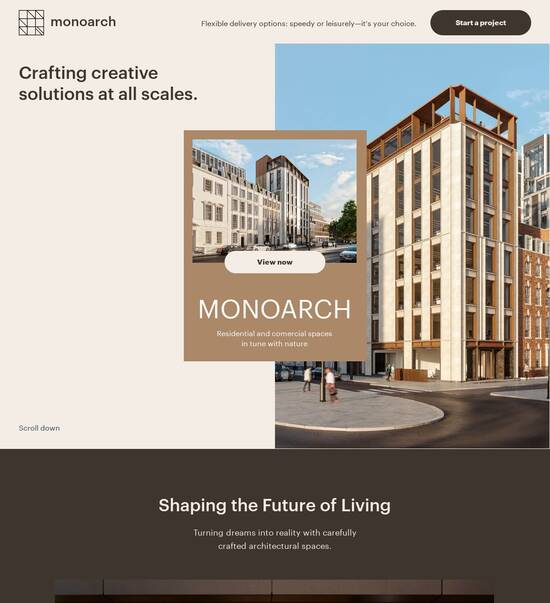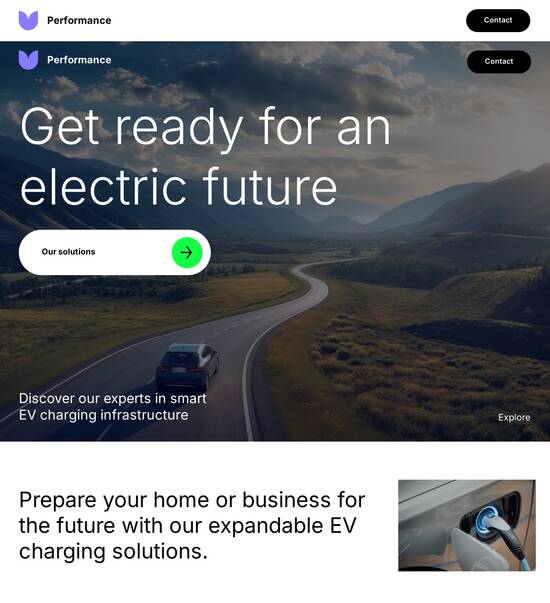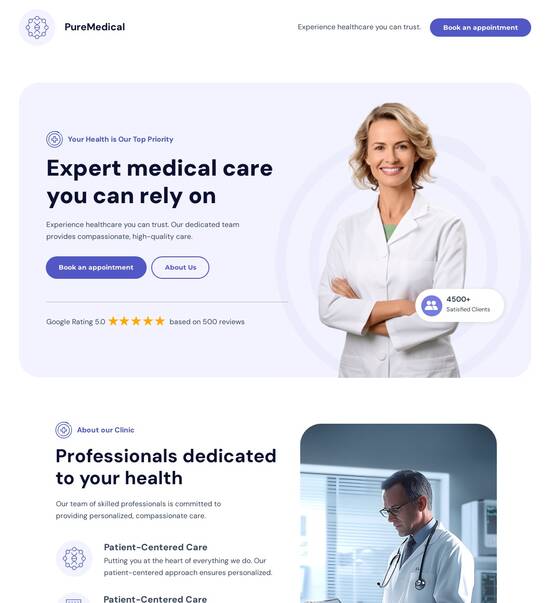
Next.js optimized live chat page template
Explore Similar TemplatesAbout template
Supercharge your live chat page with Next.js for outstanding performance! Learn more today.
Recommended templates

Easy to build without coding
With the intuitive drag-and-drop builder, anyone on your team can create high-converting pages without any knowledge of code or design. Make enhancements to your landing page with custom widgets using Javascript, HTML/CSS, or third-party scripts.

Multiple layouts for any industry and goal
Select from 500+ landing page layouts built to boost conversions across industry-specific scenarios. Customize them by adjusting fonts, adding images, and generating on-brand content with the AI assistant. Quickly scale with Instablocks® and Global Blocks that you can save, reuse, and update globally.

Loads fast and looks polished on any device
Every template is responsive, which means they present professionally on any device and load blazingly fast with our Thor Render Engine. You can also power them up with Google AMP technology to deliver an unparalleled mobile experience and drive higher conversions.

Robust analytics & experimentation
Get real-time updates and reporting across all your devices, showing the number of visitors, conversions, cost-per-visitor, and cost-per-lead. Launch AI-powered experiments, run A/B tests, and use heatmaps to analyze user behavior, then optimize your landing page to maximize conversions.







Easy to build without coding
With the intuitive drag-and-drop builder, anyone on your team can create high-converting pages without any knowledge of code or design. Make enhancements to your landing page with custom widgets using Javascript, HTML/CSS, or third-party scripts.
Multiple layouts for any industry and goal
Select from 500+ landing page layouts built to boost conversions across industry-specific scenarios. Customize them by adjusting fonts, adding images, and generating on-brand content with the AI assistant. Quickly scale with Instablocks® and Global Blocks that you can save, reuse, and update globally.
Loads fast and looks polished on any device
Every template is responsive, which means they present professionally on any device and load blazingly fast with our Thor Render Engine.
Robust analytics & experimentation
Get real-time updates and reporting across all your devices, showing the number of visitors, conversions, cost-per-visitor, and cost-per-lead. Launch AI-powered experiments, run A/B tests, and use heatmaps to analyze user behavior, then optimize your landing page to maximize conversions.
All the features you need to build lead-generating landing pages
Explore more featuresLearn how to build top-performing landing pages for any goal
FAQs
Leading the way in building high-performing landing pages





A comprehensive guide to maximizing your digital marketing with Instapage landing pages
The effectiveness of your digital marketing campaigns heavily relies on well-optimized landing pages. Instapage offers a robust platform that enables marketers to create high-converting landing pages efficiently. In this guide, we'll explore how you can leverage Instapage's features to boost your campaigns, regardless of your budget or team size.
Understanding landing page optimization
Landing page optimization is crucial for improving your conversion rates and maximizing your return on investment (ROI). Instapage equips marketers with tools to analyze user behavior through heatmaps, enabling you to identify which areas of the page attract attention. By running A/B tests, you can iterate on your designs and content to find the most effective variations, leading to an increased likelihood of conversions.
- Analyze visitor engagement: Use Instapage's heatmaps to visualize where users click.
- Test different elements: Run A/B tests on headings, images, and calls-to-action.
- Monitor performance metrics: Leverage the analytics dashboard to track conversion rates and bounce rates.
Creating your landing page with Instapage
Creating a landing page with Instapage is straightforward thanks to its user-friendly interface. Start by selecting a template that aligns with your campaign objectives, then customize it using drag-and-drop features.
- Choose a template: Start with one of the 100+ conversion-focused templates available.
- Customize your design: Use the intuitive builder to add images, videos, and custom text.
- Incorporate lead generation elements: Utilize pre-built lead gen components to capture visitor information.
Personalizing user experiences
Personalization can lead to superior conversion rates, and Instapage provides tools to segment audience experiences effectively. By using dynamic text replacement and AdMaps, marketers can customize content based on user data, fostering a more engaging experience.
- Dynamic text replacement: Automatically adjust text on landing pages to match ad copy.
- AdMaps: Align specific advertisements with targeted landing pages for enhanced relevance.
- Audience tracking: Monitor metrics to understand which segments perform best.
In conclusion, Instapage offers diverse features and tools designed to optimize your digital marketing efforts. With its emphasis on user experience and data-driven decisions, marketers can achieve unprecedented levels of success.
Ready to take your digital marketing to the next level? Start using Instapage's powerful landing page solutions today to boost your campaign performance.
Next.js optimized live chat page template
Understanding Next.js and its role in modern web applications
Next.js is a powerful React framework that stands out in the world of modern web development. It provides an array of functionalities that enhance the performance and user experience of web applications. With features like server-side rendering, static site generation, and API routes, it empowers developers to build robust applications that are quick and SEO-friendly.
The ability to render pages on the server before sending them to the user allows for faster load times, which is critical in retaining visitors. Static site generation further bolsters this by pre-rendering pages at build time, making them instantly available to users. The integration of API routes simplifies interactions with databases and third-party services, crafting seamless web applications.
As more businesses realize the significance of effective communication, live chat has emerged as a vital tool in maintaining customer engagement. The immediacy of live chat enhances customer support while allowing personalized interaction, boosting customer satisfaction.
Server-side rendering for enhanced performance
Static site generation for improved SEO
API routes for streamlined backend operations
Exploring the Next.js optimized live chat feature
The Next.js optimized live chat template offers key features designed to simplify real-time communication. Real-time messaging capabilities ensure that conversations flow smoothly, while instant notifications keep both customers and support staff informed of ongoing interactions. The ability to integrate with existing systems, such as CRMs and help desks, makes this template invaluable for businesses looking to enhance their support capabilities.
Notably, built-in support for automated responses and chatbots enhances the user experience. Businesses can save time and resources by deploying chatbots for standard inquiries. This not only streamlines operations but also enables human agents to focus on more complex issues.
Real-time messaging for immediate support
Automated responses and chatbots for efficiency
Seamless integrations with CRMs and help desks
Another benefit of the Next.js live chat template is its versatility across multiple sectors, from e-commerce to tech support. Different industries can leverage these features to improve customer experiences, leading to increased conversion rates.
Template structure and customization options
Understanding the anatomy of a Next.js live chat template helps developers implement and customize the feature effectively. The core components include the chat window, user input area, and conversation history display. Each component plays a role in facilitating the conversation while ensuring that the interface is user-friendly.
Customization options are fundamental, allowing businesses to align the chat experience with their brand identity. Color schemes, fonts, and layouts can be modified to create a cohesive visual experience. Furthermore, incorporating a company logo solidifies brand recognition during interactions.
Customizable colors and typography
Personal branding with logos
Support for multiple languages and RTL text
Multilingual support is critical in today's global marketplace. By enabling right-to-left (RTL) configuration, the template can cater to diverse audiences, ensuring accessibility and ease of use.
Navigating the development process
Setting up the live chat template within a Next.js project is a straightforward process. The first step involves initializing the project to create a robust environment tailored for development. Following initialization, developers must install the necessary libraries and dependencies to ensure that the chat features operate smoothly.
Integrating live chat functionality requires code snippets that demonstrate critical features, such as message handling and real-time updates. Utilizing Next.js APIs efficiently allows developers to fetch data seamlessly, minimizing latency and improving user satisfaction.
Initialize the project using create-next-app
Install chat-related dependencies
Implement real-time message handling
Finally, considering deployment best practices will ensure that the live chat feature maintains low latency and high availability. Regular monitoring and optimization after deployment will help in maintaining the performance of the application.
Documentation and resources
Comprehensive documentation is crucial for empowering developers to utilize templates fully. Well-structured documentation helps streamline the process of implementation, allowing teams to understand functionalities quickly. Important sections should include API references and setup guides, providing a complete overview of template capabilities.
Moreover, engaging with community and support networks enhances the development experience. Developer forums and GitHub repositories serve as valuable resources for troubleshooting and sharing ideas. Tutorials and examples found in these spaces can facilitate enhancements, ultimately leading to improved live chat capabilities.
Detailed API references for easy integration
Step-by-step setup guides
Support forums for real-time help
Maximizing the benefits of the live chat feature
Enhancing user experience through real-time communication is one of the greatest advantages of implementing a live chat feature. Users appreciate the convenience of having access to immediate support, which often leads to smoother customer journeys. The psychological impact of this instant support fosters user trust and increases retention, as customers feel valued and understood.
Additionally, gathering and analyzing chat data provides invaluable insights for businesses. By reviewing chat metrics, companies can adjust their strategies based on real user feedback. This data-driven approach aids in improving services and ensuring that customer needs are met effectively.
Immediate support increases user satisfaction
Actionable insights from chat data
Informed decision-making for better services
Developer-centric advantages of using Next.js for live chat
Using Next.js for developing a live chat feature streamlines the development workflow. Rapid iteration of templates becomes possible, allowing developers to make changes quickly without extensive downtime. The server-side capabilities of Next.js also enable enhanced performance, making it easier for applications to handle multiple requests efficiently without compromising on speed.
Engaging with the Next.js ecosystem provides additional resources, including plugins, modules, and community-driven extensions that can enhance functionality. Following best practices for code maintenance, particularly in collaborative environments, ensures that the project remains manageable and scalable as it grows.
Rapid iteration for quick updates
Enhanced performance through server capabilities
Access to community resources and extensions
Case studies and real-world applications
Several companies have successfully implemented live chat pages using the Next.js framework, significantly transforming their customer service operations. For example, a leading e-commerce company recorded a 30% increase in customer engagement after integrating a robust live chat solution powered by Next.js. Metrics such as average response time and customer satisfaction scores improved dramatically, serving as concrete examples of the impact of effective web communication.
Learning from these successful deployments involves analyzing challenges encountered during development and launch phases. Many companies found that user interface design was crucial in ensuring customers felt comfortable using the chat feature. These lessons can contribute to refining future iterations of the live chat template.
Improvement in engagement metrics post-implementation
Challenges in UI design leading to user feedback
Opportunity for iterative learning from real-world deployments
The future of live chat integration with Next.js
As customer interactions continue to evolve, the predictions for live chat functionalities appear promising. The role of artificial intelligence and machine learning in live chat experiences is set to grow. These technologies can enhance chatbots with greater contextual understanding and predictive capabilities, leading to improved interactions.
Businesses must prepare for future developments by ensuring that their web applications remain scalable and adaptable. As preferences shift and new technologies emerge, the ability to integrate these features into existing frameworks like Next.js will be crucial to maintaining competitive advantages.
Introduction of AI for smarter chat interactions
Need for scalability in design and implementation
Adapting to emerging technologies for improved functionality
Conclusion: The transformative power of Next.js live chat pages
In summary, the Next.js optimized live chat page template democratizes the ability for businesses to engage customers effectively. Its comprehensive features and customization options make it a robust solution for enhancing customer communication. The observed improvements in user experience and engagement metrics highlight the importance of integrating such capabilities in today's digital landscape.
Final thoughts suggest that Next.js offers a pathway to building powerful, responsive web applications. As the landscape of customer interaction continues to shift, leveraging technologies like Next.js will empower businesses to create meaningful user experiences and build lasting customer relationships.
Ready to skyrocket conversions?
Supercharge your ad campaigns with high-performing landing pages
Get started














